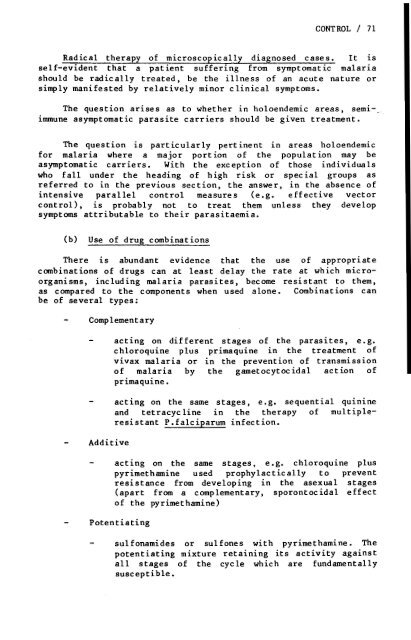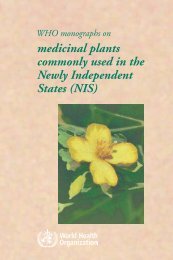Drug-Resistant Malaria - libdoc.who.int - World Health Organization
Drug-Resistant Malaria - libdoc.who.int - World Health Organization
Drug-Resistant Malaria - libdoc.who.int - World Health Organization
You also want an ePaper? Increase the reach of your titles
YUMPU automatically turns print PDFs into web optimized ePapers that Google loves.
CONTROL / 71<br />
Radical therapy of microscopically diagnosed cases. It is<br />
self-evident that a patient suffering from symptomatic malaria<br />
should be radically treated, be the illness of an acute nature or<br />
simply manifested by relatively minor clinical symptoms.<br />
The question arises as to whether in holoendemic areas, semi-.<br />
immune asymptomatic parasite carriers should be given treatment.<br />
The question is part icularly pert inent in areas holoendemic<br />
for malaria where a major portion of the population may be<br />
asymptomatic carriers. With the exception of those individuals<br />
<strong>who</strong> fall under the heading of high risk or special groups as<br />
referred to in the previous section, the answer, in the absence of<br />
<strong>int</strong>ensive parallel control measures (e.g. effective vector<br />
control), is probably not to treat them unless they develop<br />
symptoms attributable to their parasitaemia.<br />
(b)<br />
Use of drug combinations<br />
There is abundant evidence that the use of appropriate<br />
combinations of drugs can at least delay the rate at which microorganisms,<br />
including malaria parasites, become resistant to them,<br />
as compared to the components when used alone. Combinat ions can<br />
be of several types:<br />
Complementary<br />
Additive<br />
acting on different stages of the parasites, e.g.<br />
chloroquine plus primaquine in the treatment of<br />
vivax malaria or in the prevention of transmission<br />
of malaria by the gametocytoc idal act ion of<br />
primaquine.<br />
acting on the same stages, e.g. sequential qUlnlne<br />
and tetracyc line in the therapy of multipleresistant<br />
P.falciparum infection.<br />
acting on the same stages, e.g. chloroquine plus<br />
pyrimethamine us.ed prophylactic ally to prevent<br />
resistance from developing in the asexual stages<br />
(apart from a complementary, sporontocidal effect<br />
of the pyrimethamine)<br />
Potentiating<br />
sulfonamides or sulfones with pyrimethamine. The<br />
potentiating mixture retaining its activity against<br />
all stages of the cycle which are fundamentally<br />
susceptible.
















